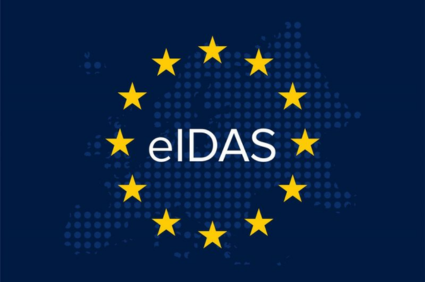This EU regulation, Electronic Identification, Authentication, and Trust Services, was enacted in 2014 to bolster online security for e-business transactions within the digital single market. It sets a common foundation for secure electronic interactions, helping to prevent online fraud and boosting confidence in electronic transactions.
The eIDAS framework provides a basis for cross-border electronic transactions, paving the way for secure and seamless interactions between businesses, citizens, and public authorities. It ensures that individuals and companies can use their own national electronic identification schemes (eIDs) to access public services in other EU countries where eIDs are available. This EU regulation considerably impacts the digital economy, enhancing trust in electronic transactions and facilitating cross-border public digital services under secure conditions.
The eIDAS regulation sets robust standards for electronic transactions, including creating and verifying digital signatures and electronic seals, time stamps, electronic delivery service, and website authentication. By fostering a predictable regulatory environment for electronic identification and trust services, the eIDAS framework is a critical enabler of the digital single market, driving innovation and competitiveness in the European digital economy.
What does ‘eIDAS’ mean?
‘eIDAS’ is an acronym for Electronic Identification, Authentication and Trust Services. It refers to a set of standards for electronic identification and trust services for electronic transactions in the European Single Market. This EU regulation establishes a legal framework for electronic identification, offering a predictable environment for electronic transactions within the European Union, thereby enhancing online security and data protection.
eIDAS is designed to ensure the integrity, authenticity, and confidentiality of electronic transactions. It provides robust rules for using digital signatures, electronic seals, time stamps, electronic delivery service, and website authentication. Furthermore, eIDAS establishes a legal framework for electronic identification, enabling citizens and businesses to use their own national eID schemes to access public services in other EU countries.
The eIDAS regulation is pivotal for building trust in the digital single market. By providing a common set of standards for electronic transactions, eIDAS enables secure and seamless electronic interactions between businesses, citizens, and public authorities. It facilitates cross-border electronic transactions and enhances the overall security of online services, thereby advancing online authentication and cybersecurity.
What changes does eIDAS 2.0 bring?
eIDAS 2.0, the updated version of the eIDAS regulation, brings several significant changes, all aimed at enhancing online security, data protection, and digital identity. It aims to enhance the effectiveness of the original regulation and extend its benefits to a broader range of services. The overarching goal of eIDAS 2.0 is to foster innovation, enhance trust in the digital single market, and facilitate cross-border electronic transactions. One of the key changes in eIDAS 2.0 is the expansion of the scope of the regulation to include private sector entities. This means that private sector organizations can now also provide electronic identification and trust services, thereby increasing the availability and accessibility of these services. Another significant change is the introduction of a new framework for electronic identification interoperability, which will facilitate cross-border access to services.
eIDAS 2.0 also introduces new provisions to enhance the security of electronic transactions. These include stricter requirements for the security of electronic identification means and enhanced supervision of trust service providers. In addition, eIDAS 2.0 provides for the establishment of a European blockchain services infrastructure, which will further enhance the security and efficiency of electronic transactions. Overall, eIDAS 2.0 represents a significant step forward in the evolution of the digital single market, fostering innovation and competitiveness in the European digital economy.
On February 29, 2024, the European Parliament gave its approval to amend the eIDAS Regulation, pending anticipated approval from the Council in March.
The European Parliament endorsed the revision of Regulation EU 920/2014, commonly referred to as the ‘eIDAS Regulation,’ following negotiations among the EU Parliament, Council, and Commission. The vote count stood at 335 in favor, 190 against, with 31 abstentions.
The approved text will proceed through formal adoption procedures in the Council, with the final adoption expected in March. Subsequent publication in the EU’s Official Journal is anticipated in April, and the text is expected to take effect between April and May 2024.
Exploring the EU Digital Identity Wallet
The EU Digital Identity Wallet is a pioneering digital platform developed by the European Union. This robust platform is designed to offer a secure and universal method of electronic identification across the EU, enhancing online security and streamlining digital transactions. As part of the EU’s broader initiative to establish a single digital market, this wallet is poised to simplify digital interactions across several sectors, including healthcare, banking, and public services. This digital identity tool also serves as a secure storage for personal data, reinforcing data protection and online authentication. Users are granted full control over their data, with the ability to manage who can access their information and for what purpose. The EU Digital Identity Wallet is built on the principles of data minimization, purpose limitation, and transparency, embedding privacy and data protection at the heart of its operations. Interoperability is a key feature of the EU Digital Identity Wallet, allowing usage across all EU member states, irrespective of the user’s nationality or residence. This feature is advantageous for individuals who frequently travel or conduct business across EU countries. It eliminates the need for multiple identity verification methods and simplifies accessing services across borders.
How will the Digital Identity Wallet be used?
The EU Digital Identity Wallet will serve as a universal digital identity verification tool across the European Union. It will be utilized to access a broad range of online services, from banking and healthcare to public services and e-commerce. The wallet can also be used for age verification, digital signatures, and potentially as a digital driving license or passport. Users will have the power to control who can access their data and for what purpose, ensuring robust data protection and privacy. The EU Digital Identity Wallet will also enable secure online transactions, mitigating the risk of identity theft and fraud, thereby strengthening cybersecurity.
Who will develop the EU Digital Identity Wallet?
The development of the EU Digital Identity Wallet is a collaborative effort involving the European Commission, EU member states, and various stakeholders in the digital sector. The European Commission spearheads the initiative, providing the strategic direction and EU regulation framework for developing the digital wallet.
The individual member states will undertake the actual development and implementation of the EU Digital Identity Wallet in line with the guidelines and standards set by the European Commission. This approach ensures that the digital wallet is adaptable to each member state’s specific needs and circumstances while maintaining high interoperability and consistency across the EU. Various stakeholders in the digital sector, including tech companies, digital service providers, and data protection authorities, are also involved in the development process. Their expertise and input are crucial in ensuring the EU Digital Identity Wallet is secure, user-friendly, and compliant with data protection regulations.
Impact of eIDAS 2.0 on Countries and Sectors
The introduction of eIDAS 2.0, a significant evolution of EU regulation, is expected to impact the digital identity landscape across the European Union profoundly. This new framework, which focuses on online security and data protection, is designed to streamline digital transactions, reinforce trust in electronic services, and promote the digital single market. The influence of eIDAS 2.0 extends beyond EU member states, affecting countries within the European Economic Area (EEA) and those engaged in cross-border digital transactions with the EU.
The sectors most likely affected by eIDAS 2.0 include finance, healthcare, e-commerce, and public administration. These sectors heavily depend on digital transactions and electronic identification, making them prime targets for the enhanced online security and trust mechanisms introduced by eIDAS 2.0. For instance, eIDAS 2.0 can facilitate secure and seamless cross-border digital transactions in the finance sector, fostering greater economic integration within the EU.
Which countries and sectors will be affected by eIDAS 2.0?
All EU member states, EEA countries, and nations involved in digital transactions with the EU will be affected by the eIDAS 2.0 regulation. This EU regulation requires these countries to recognize and accept electronic identification and trust services from other countries that comply with eIDAS 2.0. This recognition extends to digital signatures, electronic seals, time stamps, electronic delivery services, and website authentication, all crucial components of online security.
The sectors most affected by eIDAS 2.0 heavily rely on digital transactions and electronic identification. These include the finance sector, e-commerce, healthcare, and public administration. The regulation will also impact the IT sector, as companies must ensure their software and systems comply with eIDAS 2.0 requirements for data protection and cybersecurity.
What changes will eIDAS 2.0 bring to these areas?
The eIDAS 2.0 regulation will significantly change these areas by enhancing digital transactions’ security, trust, and efficiency. It will facilitate the seamless cross-border exchange of electronic identification and trust services, promoting economic integration within the EU and other countries.
eiDAS 2.0 will streamline digital transactions in the finance sector, making them more secure and efficient. This will encourage more consumers and businesses to engage in cross-border transactions, fostering economic growth. eiDAS 2.0 will enhance the security and trust in electronic health records and telemedicine services for the healthcare sector, improving patient care and outcomes. In e-commerce, the regulation will boost consumer trust in online transactions, promoting the growth of the digital single market. eiDAS 2.0 will facilitate secure and efficient digital services for public administration, improving public service delivery and citizen engagement. In conclusion, the eIDAS 2.0 regulation will profoundly impact countries and sectors across the EU and beyond, fostering a secure, trustworthy, and efficient digital single market.
Security and Privacy under eIDAS 2.0
The European Union’s eIDAS 2.0 regulation is critical in ensuring online security and data protection in the digital identity landscape. This EU regulation provides a robust electronic identification and trust services framework, thereby bolstering cybersecurity across member states. eIDAS 2.0 legally recognizes the use of digital signatures, electronic seals, and time stamps, thereby enhancing the security of online transactions.
Interoperability of electronic identification schemes is a crucial aspect of eIDAS 2.0. This EU regulation stipulates that an electronic identification issued in one EU member state should be recognized in all other member states. This ensures seamless online authentication across borders while maintaining stringent data protection protocols.
eIDAS 2.0 also sets rigorous standards for electronic identification and trust service providers. These providers must comply with high technical and operational standards and are subject to regular audits. This ensures that the digital identity of users is managed by reliable providers, thereby enhancing online security. The regulation also provides a framework for resolving electronic identification and trust services disputes, further strengthening data protection measures.
How does the EU Digital Identity Wallet protect personal data?
The EU Digital Identity Wallet is a secure tool for managing digital identity and ensuring data protection. It employs advanced cryptographic techniques to encrypt personal data, enhancing online security. This ensures that personal data remains secure even if the user’s device is compromised.
The EU Digital Identity Wallet puts users in control of their data. Users can choose which data to store in their wallet and who can access it, preventing unauthorized access and misuse. This feature is crucial in ensuring online authentication while maintaining data protection.
The wallet is interoperable with various electronic identification schemes across the EU. This allows users to securely access multiple online services, regardless of location or the service provider. Moreover, the wallet complies with the EU’s stringent data protection laws, ensuring that users’ digital identity is managed in line with the highest data protection standards.
What is the role of pseudonyms in data protection?
Pseudonyms are a crucial tool in data protection, particularly in the context of digital identity. They allow users to conceal their real identity, thereby providing an additional layer of privacy. When a pseudonym is used, the user’s real identity is replaced with a fictitious one, making it harder for unauthorized parties to link the data to the user.
Pseudonyms are particularly useful when data needs to be shared or processed. Using a pseudonym, users can share or process data without revealing their identity. This is essential in maintaining privacy and data protection, especially when dealing with sensitive or confidential data.
The use of pseudonyms can also mitigate the risks associated with data breaches. In a breach, data linked to the pseudonym is less likely to be helpful to the attacker, as it cannot be directly linked to the user. Furthermore, data protection laws such as the EU’s General Data Protection Regulation (GDPR) encourage the use of pseudonymization as a technique to achieve data protection by design and by default, thereby enhancing online security and cybersecurity.


